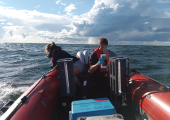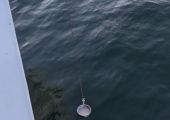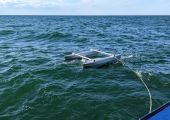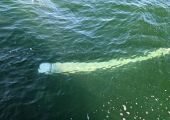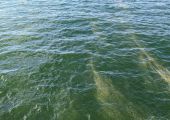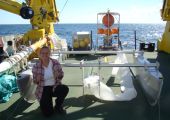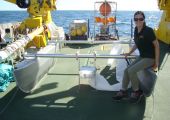
Where the Baltic Sea touches the sky - Air-Sea interaction in the Baltic Sea
14.07 - 20.07.2022 – Surfactants are ubiquitous!
In general, surfactants are special molecules that can facilitate binding of different chemical compounds that they do not naturally bind together. So, surfactants in the ocean can bind air and water molecules together, reduce surface tension and its vorticity and control gas transfer velocity (k) and air-sea exchange as the consequences.
In the oceans biological-derived surfactants in the form of soluble and non-soluble are produced via phytoplankton production, zooplankton grazing and bacterial degradation but they control exchange processes in the different way. While non-soluble surfactants form a monolayer physical barrier (like a blanket on the sea surface) and impedes molecular diffusion across the surface, soluble surfactants on the other hand, may exert greater control on air-sea exchange as they reform more quickly at the surface boundary after surface disruption by waves/winds.
Surfactants can also reduce the mixing in the boundary layer of the ocean by flattening the capillary waves caused by wind blowing across the surface. With less mixing, the very surface water becomes rich in CO2 and other trace gases and the rate at which the gas is absorbed by the Sea reduces.
Josi and myself job on board EMB295 cruise is to investigate quantification, and biogenic characterization of the sea surface microlayer. To do that, twice per day at 6am and 6pm, we take samples of the very thin sea surface layer by deploying glass plate from the ship’s rubber boat (Figure 1) or Garrett screen from the bow of the mother ship (Figure 2). We also take samples from the reference water i.e. 1m depth using a Niskin bottle manually.
The catamaran (Figure 3) and underlying water net (Figure 4) was also deployed at every designated stations to sample the sea surface and the reference depth.
So, our task is not a simple one. It is very hard to capture water from the very surface layer of the ocean when the surface is moving and you are standing on a ship/boat which is also moving. The ship itself is not free of surfactants and there is a risk of contaminating samples, so great care needs to be taken with the way water samples are captured and stored.
We also monitor the sea surface during sampling like how wavy is the surface, any breaking waves that generate bubbles or any phytoplankton bloom (Figure 5).
All the collected samples will be analyzed for several parameters including surfactant activity, colored and florescence dissolved organic matter (C/FDOM), nutrients, chlorophyll, total amino acids, total sugars, total organic carbon, gel particles (TEP and CSP), bacteria, phytoplankton, viruses and micro-phytoplankton.
We hope with combining our generated data with data from other research group on board, we can determine to what extent surfactants may control air-sea gas exchange in the Baltic Sea during productive months.
As the cruise is about to an end and everyone is getting busy with packing, we will miss all those good and challenging days we had over the last three weeks and we hope to get together in a closed future to present some of the interesting results we managed to generate on this challenging expedition.
Text:
Bita Sabbaghzadeh (IOW) and Josefine Karnatz (GEOMAR)
| Expedition: | EMB295 |
| Mission: | CenBASE |
| Start date: | 30.06.2022 |
| End date: | 19.07.2022 |
